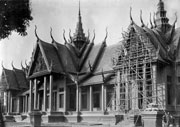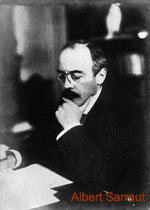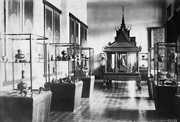
| Information for: Visitors |

Museum
History |
Collecion | Khmer Art History | Exhibitions | Projects and Activities |
| Switch to: Khmer |
MUSEUM
HISTORY
| |

|  |
Control of the National Museum and Arts Administration
was ceded by the French to the Cambodians on 9 August, 1951 and
following Independence in 1953, the then Musée National de
Phnom-Penh was the subject of Bilateral accords The museum closed between 1975 and 1979, the years of Khmer Rouge control and re-opened on 13 April 1979. |
|
BuildingThe museum is bordered by Streets 178 (to the north), Street 13 (to the east) and Street 184 (to the south). The museum buildings were constructed between 1917 and 1924, with the inauguration of the museum in 1920. The central section of the east façade was renovated in 1968 under the supervision of Cambodian architect, Vann Molyvann. Physical dimensions:East façade 97.09 m Exhibition galleries 2,800 sq m Total 5,190 sq m ObjectivesThe National Museum of Cambodia houses one of the world's greatest collections of Khmer cultural material including sculpture, ceramics and ethnographic objects from the prehistoric, pre-Angkorian, Angkorian and post-Angkorian periods. The Museum promotes awareness, understanding and appreciation of Cambodia's heritage through the presentation, conservation, safekeeping, interpretation and acquisition of Cambodian cultural material. It aims to educate and inspire its visitors. ActivitiesThe main activities of the National Museum of Cambodia
include exhibiting, safeguarding and promoting understanding of
Cambodia’s cultural and artistic treasures. Keeping objects
safe and working to ensure the repatriation of pieces stolen from
Cambodia are important aspects of the museum’s work, particularly
as looting and illicit export of cultural material are a continuing
concern. In addition, the Museum strives to engage its visitors
through its exhibitions and to fulfil its role as an integral part
of the community. The Museum believes that Cambodia’s cultural
heritage is of great value and can provide a source of pride and
identity to the Cambodian people who have lost so much in recent
decades. The availability of multilingual Museum tour guides and
Publications, as well as the Museum’s public library, all
serve to increase the accessibility of the collection both for local
and international visitors. Outside of Cambodia, the Museum has an active policy of lending objects from its collection for major international exhibitions. This practice was in place before Cambodia’s recent decades of unrest and was reinstituted in the 1990s, starting with an exhibition held at the National Gallery of Australia in 1992. Subsequent exhibitions have been held in France, the USA, Japan, South Korea and Germany. The exhibitions to Australia and France have resulted in significant professional and structural assistance to the Museum from the governments of those countries and it is hoped that international exhibitions will continue to attract such support. AchievementsThe turmoil of recent decades has devastated all aspects of Cambodian life including the cultural realm. During the years of Khmer Rouge control the Museum, along with the rest of Phnom Penh, was evacuated and abandoned. The Museum suffered from neglect during this time and after the liberation of Phnom Penh on 7 January 1979 it was found in disrepair, its roof rotten, collection in disarray and garden overgrown. The Museum was quickly tidied up and reopened to the public on 13 April 1979. Tragically, however, many of the Museum's employees had lost their lives during the Khmer Rouge regime. The resulting loss of expertise, combined with the deterioration of the Museum building and its collection, have made rehabilitation of the Museum a daunting task. Despite such obstacles the last decade has seen considerable progress, with generous assistance from individuals, foreign governments and numerous philanthropic organizations. In recent years the Museum has successfully addressed a range of key concerns. These include:
Display & StoreroomOn current estimates there are 1,877 works of art on display in the museum galleries with a further 12,320 items secured in the basement storeroom. This transposes into a grand total of 14,197 works with a breakdown between works on exhibition (some 15.2%) and those in storage (some 84.8%). There is one special exhibitions presently on show in the museum – ‘Post-Angkorian Buddha’ that opened in 2000.
|
|
| Contact: Webmaster | ©2013
National Museum of Cambodia This website is sponsored by the Bickford Family Trust and FOKCI |
 Groslier’s
intended museum was soon associated with the Ecole des Arts Cambodgiens
(1917) and became known as the Musée du Cambodge in 1919.
In 1920, this museum was soon to be officially renamed Musée
Albert Sarraut after the then Governor-General of Indochina.
Groslier’s
intended museum was soon associated with the Ecole des Arts Cambodgiens
(1917) and became known as the Musée du Cambodge in 1919.
In 1920, this museum was soon to be officially renamed Musée
Albert Sarraut after the then Governor-General of Indochina. Early
directors of the museum from the 1920s-1940s contributed greatly
to knowledge of the rapidly expanding collection -Groslier himself
catalogued the collection, followed by Jean Boisselier and Solange
Thierry (interim Director) who added their individual talents
to cataloguing and management.
Early
directors of the museum from the 1920s-1940s contributed greatly
to knowledge of the rapidly expanding collection -Groslier himself
catalogued the collection, followed by Jean Boisselier and Solange
Thierry (interim Director) who added their individual talents
to cataloguing and management.